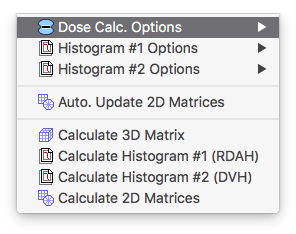When the Anisotropy F(r,θ) item is checked in the Dose calc. options menu, or the Isotropy button in the Prescription window toolbar is showing the anisotropic icon, the source anisotropy function F(r,θ) is included in the dose calculation. The anisotropy function F(r,θ) is a two-dimensional function which gives the angular variation of dose rate about a seed-shaped source at distance r due to self-filtration, oblique filtration of primary photons through the encapsulating material, and scattering of photons in the medium. F(r,θ). It is calculated by removing a geometry factor G(r,θ) from measured data. Plaque Simulator expects anisotropy data for at least r of 0.5, 1.0 and 2.0 cm.
To expedite the dose calculation, Plaque Simulator creates up to 16 F[r] lookup tables which consist of 91 F[θ] elements covering the range 0..90 degrees in increments of 1 degree. The tables are linearly interpolated from up to 20 θ,F(θ) data pairs for each r. The default data in Plaque Simulator is from the r=1 cm data in Tables VIII to XI in AAPM TG43 (Medical Physics, V22, 1995). Definition points must be entered for 0 and 90 degrees, the remaining 18 points may be distributed in any way you like.
The source length (L cm) may optionally be entered for completeness although the L parameter is not currently used by Plaque Simulator.
Note: for the BEBIG Ru106-Rh106 plaques the anisotropy kernel data accounts for beta attenuation and spectral hardening in the concave direction from a point source rather than seed anisotropy.

When the Anisotropy F(r,θ) item is checked in the Dose Calc. Options menu, or the Isotropy button in the Prescription window  is showing the anisotropic icon, the anisotropy modifier F(r,θ) is included in the dose calculation.
is showing the anisotropic icon, the anisotropy modifier F(r,θ) is included in the dose calculation.